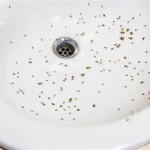How To Remove Smell From Bathroom Towels
Bathroom towels, despite their essential function in maintaining personal hygiene, are often prone to developing unpleasant odors. These smells can be attributed to various factors, primarily the accumulation of moisture and the proliferation of bacteria and mold. Damp towels provide an ideal environment for microorganisms to thrive, leading to the generation of volatile organic compounds (VOCs) that are responsible for the musty or sour smells. Understanding the causes and implementing effective cleaning and drying strategies are crucial for preventing and removing these odors.
The problem of smelly towels is a common household concern, and addressing it requires a multifaceted approach. Simply washing towels infrequently or using insufficient detergent may not be enough. A combination of proper washing techniques, thorough drying methods, and preventative measures is necessary to maintain the freshness and cleanliness of bathroom towels. Furthermore, understanding the role of different fabrics and the specific types of microorganisms involved can inform a more targeted and effective cleaning strategy.
Understanding the Causes of Odor in Towels
The primary contributor to the development of unpleasant smells in towels is the presence of moisture. When towels remain damp for extended periods, they become breeding grounds for bacteria, mold, and mildew. These microorganisms feed on organic matter, such as skin cells, soap residue, and bodily fluids that accumulate on the towel's surface. As they consume these materials, they release waste products in the form of VOCs, which create the characteristic musty or sour odor.
Several factors contribute to towels remaining damp. Inadequate ventilation in the bathroom is a significant issue, preventing moisture from evaporating quickly. Tightly packing wet towels together in a laundry hamper or leaving them crumpled on the floor also restricts airflow and prolongs drying time. The type of fabric also plays a role; thicker, more absorbent towels, such as those made from Egyptian cotton, tend to retain more moisture and take longer to dry than thinner towels.
Furthermore, the washing process itself can contribute to the problem if not done correctly. Using too little detergent may not effectively remove all the organic matter and microorganisms from the towels. Similarly, washing towels at low temperatures may not kill bacteria and mold spores. Overloading the washing machine can also prevent proper cleaning, as the towels may not have enough room to move freely and be thoroughly rinsed.
The specific types of microorganisms involved can vary, but common culprits include bacteria such as *Micrococcus* and *Bacillus*, as well as fungi like *Aspergillus* and *Penicillium*. These microorganisms are ubiquitous in the environment and readily colonize damp surfaces. Identifying the specific types of microorganisms present requires laboratory analysis, but understanding the general principles of microbial growth can inform effective cleaning and drying strategies.
Effective Washing Techniques for Odor Removal
To effectively remove odors from bathroom towels, a combination of proper washing techniques and appropriate cleaning agents is necessary. Pre-treating heavily soiled towels can significantly improve the outcome of the wash cycle. Soaking towels in a solution of water and baking soda for several hours or overnight can help to loosen dirt and neutralize odors before they are washed.
When washing towels, it is crucial to use a sufficient amount of high-quality detergent. The amount of detergent needed will depend on the size of the load and the level of soiling, but it is generally better to err on the side of using slightly more detergent than less. Choosing a detergent specifically formulated for removing odors or containing enzymes that break down organic matter can be particularly effective.
Washing towels at a high temperature is essential for killing bacteria and mold spores. A water temperature of at least 140 degrees Fahrenheit (60 degrees Celsius) is recommended for sanitizing towels. However, it is important to check the care label of the towels to ensure that they can withstand high temperatures without damage. Some fabrics may shrink or fade at high temperatures, so it may be necessary to use a lower temperature and a longer wash cycle.
Adding vinegar or baking soda to the wash cycle can further enhance odor removal. Vinegar is a natural disinfectant and deodorizer that can help to kill bacteria and neutralize odors. Adding one cup of white vinegar to the wash cycle can leave towels smelling fresher. Similarly, baking soda is an alkaline substance that can help to absorb odors and balance the pH of the water. Adding one-half cup of baking soda to the wash cycle can also improve the effectiveness of the detergent.
It is important to avoid using fabric softeners when washing towels. Fabric softeners can leave a residue on the towels that can trap moisture and provide a food source for bacteria. This residue can also reduce the absorbency of the towels, making them less effective at drying. If desired, a small amount of white vinegar can be used as a natural fabric softener.
After the wash cycle is complete, it is essential to promptly remove the towels from the washing machine and transfer them to the dryer. Leaving wet towels in the washing machine for extended periods can encourage the growth of bacteria and mold, leading to the development of unpleasant odors.
Thorough Drying Methods to Prevent Odor
Thorough drying is just as important as washing when it comes to preventing odors in bathroom towels. The goal is to completely eliminate any moisture from the towels as quickly as possible. Several effective drying methods can be employed, depending on the available resources and the type of towel.
Using a clothes dryer is the most common and efficient method for drying towels. Tumble drying towels on high heat will quickly evaporate any remaining moisture and kill any lingering bacteria or mold spores. However, it is important to avoid over-drying towels, as this can damage the fibers and make them less absorbent. Removing the towels from the dryer while they are still slightly damp and allowing them to air dry for a few minutes can help to prevent over-drying.
When using a clothes dryer, it is also helpful to add dryer balls or wool balls to the load. These balls can help to separate the towels and improve air circulation, allowing them to dry more quickly and evenly. Dryer balls can also help to reduce static cling and soften the towels.
Air drying towels is another viable option, particularly in warm and well-ventilated environments. Hanging towels on a clothesline or drying rack in direct sunlight can help to kill bacteria and remove odors. The ultraviolet (UV) radiation from the sun has natural disinfecting properties that can help to sanitize the towels. However, it is important to avoid leaving towels in direct sunlight for extended periods, as this can cause them to fade or become brittle.
If air drying towels indoors, it is important to ensure that the area is well-ventilated. Opening windows or using a fan can help to increase air circulation and speed up the drying process. Hanging towels on a towel rack or over a shower rod allows for maximum airflow and prevents moisture from being trapped. Avoiding overcrowding the towels and ensuring that each towel has enough space to dry properly is crucial.
Regardless of the drying method used, it is important to ensure that the towels are completely dry before storing them. Folding or stacking damp towels together can create a breeding ground for bacteria and mold, leading to the development of unpleasant odors. Storing towels in a cool, dry, and well-ventilated area can also help to prevent the growth of microorganisms.
In situations where towels are frequently damp, such as in a gym or spa, consider using a towel warmer. Towel warmers provide a consistent source of heat that can help to dry towels quickly and prevent the growth of bacteria and mold. They are available in a variety of sizes and styles to suit different needs and preferences.
Preventative Measures for Long-Term Freshness
In addition to proper washing and drying techniques, implementing preventative measures can significantly reduce the likelihood of odors developing in bathroom towels. These measures focus on minimizing moisture accumulation and preventing the growth of microorganisms.
Encouraging members of the household to properly hang towels after each use is a crucial step. Spreading towels out on a towel rack or hook allows for maximum airflow and promotes quicker drying. Avoid leaving towels crumpled on the floor or balled up in a pile, as this restricts airflow and prolongs drying time.
Improving ventilation in the bathroom can also help to prevent moisture buildup. Ensuring that the bathroom has a working exhaust fan and using it during and after showers or baths can help to remove excess moisture from the air. Opening windows or doors to increase airflow can also be beneficial.
Regularly laundering bathroom towels is essential. Washing towels at least once a week, or more frequently if they are heavily used, can help to remove accumulated dirt, soap residue, and microorganisms. Establishing a consistent laundry schedule can help to prevent odors from developing in the first place.
Consider alternating between multiple sets of towels. Rotating towels allows each set to fully dry between uses, reducing the risk of moisture buildup. This is particularly important for thicker, more absorbent towels that take longer to dry.
Using a dehumidifier in the bathroom can further reduce moisture levels and prevent the growth of microorganisms. Dehumidifiers remove excess moisture from the air, creating a less favorable environment for bacteria and mold. They are particularly useful in bathrooms that are prone to high humidity levels.
Periodically sanitizing the washing machine can also help to prevent odors from transferring to the towels. Running an empty wash cycle with hot water and bleach or vinegar can help to kill any bacteria or mold that may be present in the washing machine. Cleaning the washing machine's detergent dispenser and rubber seals can also help to prevent the buildup of residue that can contribute to odors.
By implementing these preventative measures in conjunction with proper washing and drying techniques, it is possible to maintain the freshness and cleanliness of bathroom towels and prevent the development of unpleasant odors. Regular maintenance and attention to detail are key to ensuring that towels remain hygienic and odor-free for an extended period.

How To Deep Clean Towels Remove Mildew Smell Bacteria

How To Clean Smelly Towels The All Natural Way Andrea Dekker

7 Best Mold Mildew Resistant Towels How To Remove The Smell Help For You

Easiest Laundry Stripping Recipe To Deep Clean Smelly Towels

How To Remove Mildew Smell From Towels And Clothes Mom 4 Real

How To Deep Clean Smelly Towels

How To Clean Mold Mildew From Towels Easy Safe Methods

How To Remove Mildew Smell From Towels One Hundred Dollars A Month

How To Clean Smelly Towels The All Natural Way Andrea Dekker

How To Get Mildew Smell Out Of Towels The 3 Best Ways 2025
Related Posts







